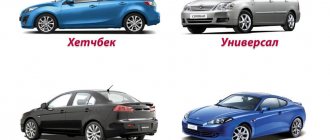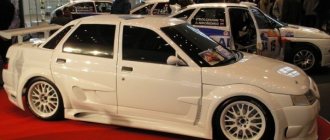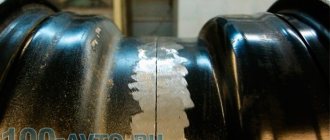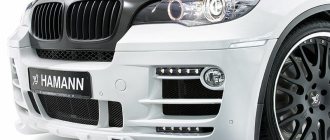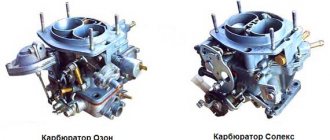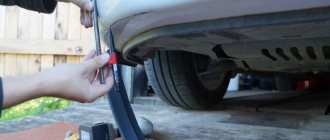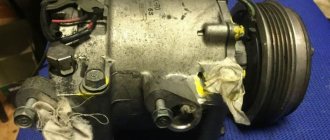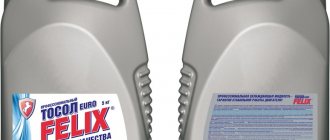Tuning the body of the VAZ 2106
The presence of weak points is typical for the bodies of domestic cars. The beloved “six” is no exception in this regard. If you carry out body tuning on a VAZ 2106, you can significantly strengthen it and remake it with high quality. It is recommended to pay special attention to the front and bottom, as the weakest points of the body of this car.
Creating panels from individual segments welded together
Body panels can be created from multiple segments welded together. To do this, a wire frame is used as a basis (to control and maintain the shape), onto which all parts of the panel are welded. Depending on the size and shape, reinforcements may be added to the back of the panel. This method allows you to avoid molding complex panels using special molding machines.
Making a full-scale base model for creating a body
To create a body, you need to make a base model. Using this base, it will be possible to customize sheet metal (formed with an English wheel machine or with hammers and mallets and applied to the model at each stage), or to mold fiberglass impregnated with polyester resin. After the body is molded, the base model does not participate in any way in the car's structure, and the finished panels are attached to the structural elements of the car's structure.
A computer (CAD or Alias program) can be used for design with further printing of full-scale drawings on a plotter. There are also ready-made templates for popular cars in electronic form, which can be purchased or found freely available on the Internet. There are also American companies that can make custom templates for the basic layout of any car.
A virtual layout diagram for creating a copy of the Mercedes-Benz SLR 300 body.
You can also use the old method of creating a base layout, without using a computer. It has its advantages. The old method of creating a mock-up base has been used by coachbuilders for many years. To do this, a drawing of all sides of the car must be drawn (see illustration) with a scale, which is drawn into squares.
In actual size, the distance between lines is 10 inches (25 cm). Using squares it will be easier to control the size and shape when making a layout. Next, to get a three-dimensional model of the drawings, you need to make a small model of the car. The model can be made from modeling clay or plasticine. As you work with clay, you will likely change a lot in your design as you get closer to the final form. This happens because the model appears to you from a different perspective. After changes in the design, you need to make changes to the drawing.
Next, the molded model is cut into transverse segments, which are outlined along the contour (see photo), and cardboard templates are made from them. Since both sides of the car are symmetrical, templates for the second side can only be made on one side. Each template should be numbered according to its location.
The next step is to enlarge these templates to full size. A projector is used to enlarge and transfer to paper. If you don’t have a projector, you can enlarge the templates by copying them onto large paper, maintaining the proportions (by squares). Then you need to make full-size templates. To create the final full-scale templates, 12mm birch plywood is best, but other materials can be used (discussed below). Now you need to put all the templates together to get a basic layout for molding the body.
Full-scale wooden base model for creating a replica of the Mercedes-Benz SLR 300 body.
Trying out molded sheet metal on a wooden mock-up of a sports car concept.
To make the base model, different materials can be used:
- Plywood
- MDF (cheaper version of plywood)
- Wire or fittings
- Polyurethane foam + cardboard (suitable for creating a fiberglass body)
- Plasticine or modeling clay
Full-scale mock-up for body molding, made from wire.
Different materials for creating a base layout have different features. Wood gives good visualization during the construction process, but burns when body panels are cooked on it. The open design (wire frame) bends well into different curves of the body, and provides easy access from the reverse side for hammering and supporting the sheet metal. Cardboard and polyurethane foam, which creates the main volume, are well suited for creating a fiberglass body (we will discuss this process below). Modeling clay is convenient in this process, but the most expensive thing. To create a full-scale model you will need more than 200 kg of clay. The cost of plasticine or clay will pay off if it is reused.
Once the 3D car model design is complete, it will serve as a mold to form the sheet metal for the car body or fiberglass body.
Creating your own body design
Many car enthusiasts dream of owning one single car with an unusual design, the car of their dreams. You can design and make such a car yourself. The beginning of planning the design and construction of a car begins with an idea. The design can be individual, or combine existing shapes taken from other cars. For example, it could be the front that looks like one car and the rear that looks like another. When the image of your car is invented, you need to draw it. There are many graphics computer programs available to help you plan and design your car. Having decided what your car will look like, you need to understand what wheelbase will suit it. You need to choose a donor that is similar in parameters so that the wheelbase matches, or it will need to be changed.
Strengthening the core of the popular “eight”, 2110 and 21099
It's no secret that initially at the factory the body of this model was not built to be strong enough. As soon as the driver of the G8, 2110 or 21099 drove onto some hill, problems immediately arose or the crab even broke. It turns out that for 2108, 2110 and 21099, strengthening is not just a preventive procedure, but a necessity.
Let's consider a couple of options for strengthening the G8 body.
- Installation of a frame assembled from metal profiles. Thus, it will be possible to significantly strengthen the body. During the work, you will have to cut out the spars, leaving only their internal parts.
- Bend the profiles to the shape of the side members and then weld them.
- You will also need to hammer pieces of pipes into the sills and then connect them to the new side members.
At the final stage of the operation, it is imperative to coat all parts with anti-corrosion agent to protect against the effects of rust.
Another option for strengthening the “eight” involves installing a special device on the rear of the body. This could be a 3-dimensional sports stretch or just a stretch.
Modernization of the VAZ body
Such modernization will significantly increase the strength of the body, and the performance of the running vehicle will significantly increase.
If you want everything to go through at the official level and not have any problems with the law, it is recommended to use a spacer. This reinforcing element, as a rule, is supported by the necessary permission for installation on AvtoVAZ. Thus, by installing this element, you can be sure that the warranty will be maintained and there will be no problems from law enforcement agencies.
The strut for the rear of the V8 is created using innovative technologies. The element very effectively eliminates rear wobble indicators 2108, 21099 and 2110 while the vehicle is moving.
After installing the spacer on 2108, 2110 and 21099, driving on bad roads will no longer bring any inconvenience. The amplifier will not allow stability to decline, even at high speed. The alignment of movement when passing holes and potholes in the roadway will become more noticeable.
It is no secret that when strengthening the body of all Samara models, the main importance is given to the rigidity indicator. It is this parameter, also called TQ (torsional stiffness), that is relevant in terms of safety.
In addition to the fact that the spacer can be purchased ready-made, there is the possibility of making the structure yourself. It will be enough to prepare several pipes of suitable diameter and special fasteners.
Fiberglass body molding
Sports cars with fiberglass bodies appeared at the end of 1951.
The 1953 Chevrolet Corvette was the first production car to feature a fiberglass body.
The 1953 Chevrolet Corvette was the first production car with a fiberglass body.
The man demonstrates the light weight of the body. The fiberglass body can be molded entirely, in one solid piece.
The advantages of a fiberglass body are light weight, low cost when produced in small quantities, and non-corrosion. The disadvantages are the low visual quality of the resulting surface, which requires further leveling; fiberglass cannot play the role of a load-bearing structure capable of withstanding significant loads, so it must be installed on a frame.
To create a layout, today it is popular to use cardboard (as the main base layout, the creation of which is described above) with construction foam (to fill the gaps between cardboard templates) and further finishing the unevenness with putty.
The process of making a model of the basis of a car body using polyurethane foam.
There are two ways to form fiberglass panels. Both methods require creating a full-scale mockup (as described above).
- The body is molded directly on top of the layout. This forming will require further leveling with putty, as the surface will be rough.
- The surface of the layout is perfectly leveled and even painted. It is made into a mold using polyester resin and fiberglass. Next, the resulting form is enhanced. Its interior is very smooth and can be used to create copies of fiberglass panels with a much smoother surface than with the first method. If you need to create several copies of identical parts, then it is better to create such a shape. In other cases, fiberglass is molded directly over the full-size model.
Homemade Lamborghini
Do you think that today this trend of passion for homemade cars is already a thing of the past? No matter how it is! Here's a modern example of car building in a garage. Here is a Lamborghini clone with a motorcycle engine. The sports car was created by a farmer from Asia.
Kit car
This is another way to make a car with your own hands. A kit car (from the English kit-car) is a car kit that is sold by the manufacturer as a set of spare parts and contains detailed assembly instructions, and the buyer then assembles it himself. Typically, major mechanical systems such as the engine and transmission are taken from the donor vehicle or purchased new from individual manufacturers.
Kit cars have been around since the early years of the automobile industry. In 1896, Englishman Thomas Hyler-White developed a design for a car that could be assembled at home.
During the 1970s, kit cars had sports car-style bodies that were designed to attach to the frame of a VW Beetle. This was popular because the car's body could easily be separated from the chassis, leaving all mechanical components attached to the frame. For this reason, the VW Beetle has become one of the most popular donors of all time. Examples of such conversions include the Bradley GT, Sterling and Sebring, which were produced in the thousands and many still survive.
Modern kit cars are replicas of famous and expensive cars. Replicas have an identical appearance to the original, but the body is made of fiberglass and polyester resin, instead of sheet metal like the original body. The attachment points for the hood, doors and trunk lid are reinforced with metal inserts laminated to fiberglass and resin.
Infinity G35 coupe, prepared for installation of a new fiberglass body.
Part of the body was cut off, a power frame of the desired shape was added. Kit cars can come in different configurations. More common are kit cars that are designed only to replace the body of a specific donor (Re-body Fiberglass Kit). For example, Vaydor Body Kit produces fiberglass bodies for the 2003–2007 Infinity G35 coupe. Part of the body is cut off and a frame is installed that matches the shape of the fiberglass body. Such a conversion requires less technical knowledge, since all the technical parts remain from a working production car.
Veydor body based on the Infinity G35 coupe.
The advantage of making a car from a kit car is that it has already been done many times before and they can help you with advice. In addition, the manufacturer himself can always provide support in creating a car. If you are making an exclusive car from scratch yourself, then you can only rely on yourself.
A set of tools and materials for work
There is no point in purchasing expensive tools for measuring geometry or an ultrasonic flaw detection device - these are unjustified costs for self-repair.
It is enough to have ordinary garage tools, replenished as needed:
- welding machine, hair dryer, soldering iron;
- simple measuring instruments;
- hammer, wooden mallet, set of keys;
- Sander;
- flux, sandpaper, white spirit, putty, polish.
Types of body defects
- small dents in some areas;
- destruction of paint and varnish, anti-corrosion coating;
- cracks, chips;
- deformation of the geometry of doors or windows.
Technical tuning of Zhiguli: increasing performance
The simplicity of the Zhiguli design makes cars of this family an ideal construction kit from which you can assemble a fast and maneuverable car. And the rear-wheel drive layout allows you to build a real car for drifting competitions or amateur circuit racing. However, to seriously improve the handling, dynamics and safety of the Zhiguli, deep improvements are required. Let's look at where you can start this process.
How to improve the handling and stability of the “classic”
Despite the classic layout (front engine, rear wheel drive), Zhigulis are characterized by mediocre handling. And cars of this family do not handle the road very well. It is quite possible to correct this situation. To do this, you need to pay attention to tuning the suspension and brakes.
Refinement of the Zhiguli suspension
The standard tuning scheme for the “classic” suspension allows you to increase its rigidity and significantly reduce roll. It consists of three stages:
- Installation of springs from Niva (VAZ 2121). The springs are more rigid, but at the same time they are ideal for installation on a Zhiguli. At this stage, you also need to replace the rubber bumpers.
- Replacing shock absorbers with sports ones. Preference should be given to gas-oil struts. The range of these components in spare parts stores is very wide.
- Installation of stiffer anti-roll bars.
Refinement of the suspension will not only improve handling and stability, but also increase comfort when driving the Zhiguli.
Improved suspension improves agility and comfort
Brake system tuning
It is worthwhile to improve the brakes on the Zhiguli before you begin to increase power and dynamic characteristics. Standard "classic" brakes have never been particularly effective or reliable, so they may simply not cope with increased speeds.
As a rule, all Zhiguli cars were equipped with front disc brakes and rear drum brakes. It is better to start the improvement process by replacing the rear brakes. Brake system tuning kits from reputable manufacturers can be purchased at parts stores, but their price can be quite high. A budget option is to install ventilated disc brakes from a VAZ-2112. They stop the car much more effectively.
Rear disc brakes significantly improve braking performance
Tuning the rear brakes comes down to replacing the drum mechanisms with disc ones. The donor could be a VAZ-2108. The front brake calipers from the “eight” or “nine” are easy to adapt and install on the “classic” as rear ones, but you will have to buy discs separately.
How to increase the power and dynamic characteristics of a “classic”
The Achilles heel of the “classics” is its dynamics. Even the most budget foreign cars pick up speed noticeably faster than Zhiguli cars. Many owners of “classic” VAZs are not ready to put up with this. They resort to tuning the engines of their cars, and also modify the exhaust system.
Video: charged “seven” against supercars at drag racing competitions
Tuning the Zhiguli engine
Owners of fuel-injected Zhiguli cars have access to chip tuning. This procedure does not require intervention in the engine structure. Changing the characteristics of the motor occurs due to adjustments to the engine software. With the help of chip tuning, you can change the level of saturation of the combustion mixture with gasoline, which, in turn, leads to changes in power and efficiency parameters.
Find out more about the design of the VAZ-2107 engine: https://bumper.guru/klassicheskie-modeli-vaz/dvigatel/dvigatel-vaz-2107-inzhektor.html
If your Zhiguli has a carburetor engine, chip tuning, unfortunately, is not available to you. However, power can be increased by installing two carburetors or increasing the diameter of the carburetor fuel and air jets. The effect of this upgrade is to speed up the flow of the air-fuel mixture into the combustion chamber.
Installing a second carburetor significantly increases engine performance, but also increases fuel consumption
If these modifications are not enough, you can use the following methods to increase the engine power of the “classic”:
- Installing a zero-resistance air filter will increase power by improving the process of saturating the combustible mixture with air. Engine performance is improved without loss of efficiency.
- Installation of compressor and turbine.
- Increasing the working volume by boring the cylinder block.
Video: chiptuning of the “Seven” engine
Exhaust system tuning
Proper modification of the exhaust system of a Zhiguli can bring an increase in power of up to 10 horsepower. Noise absorption, environmental friendliness and efficiency of the machine are sacrificed to improve performance.
The straight-through muffler is externally distinguished by an extended exhaust pipe pipe
You can reduce the resistance of the exhaust system and thereby increase power by installing a direct-flow exhaust. The difference between a conventional exhaust and a forward exhaust is the linear arrangement of the muffler chambers.
A direct-flow muffler differs from a conventional muffler in the linear arrangement of the chambers
It is worth understanding that a direct flow made by yourself may not bring an increase in power . In this case, the whole point of the changes will be only to increase the exhaust volume. For greater confidence in the results of tuning, it is best to purchase a direct-flow muffler developed by specialists for your car model.
This rule also applies to replacing the muffler “pants”. An incorrectly selected part can disrupt the operation of the cylinders. However, a high-quality manifold with reduced resistance increases engine power due to more efficient removal of exhaust gases.
Improving the safety of the “classic”
If you have seriously modernized your “classic”, made it noticeably faster and more maneuverable, you should think about increasing the level of safety. This direction of tuning becomes especially important if the car will be used in one kind of competition or another.
Four-point seat belts for driver and front passenger
Standard seat belts have a three-point fastening system. They cope with fixing the driver and passenger in the event of a frontal and side impact, but do not hold the body securely enough. Four-point seat belts can save people even in an overturned car. They come into contact with the body like the shoulders of a backpack and are securely held in the chair.
The combination of a roll cage and four-point belts is most often found on cars adapted for racing.
The lower four-point belt anchors are installed on the lower part of the seat backs, and the upper ones are installed on special eyes that must be mounted into the floor behind the driver and front passenger or into the safety cage. This usually leaves insufficient legroom for rear passengers, so four-point seat belts are mainly the province of sport modifications that do not have rear seats.
Safety frame for Zhiguli
The safety cage serves to protect the driver and passenger from injury in the most serious accidents. Most racing cars are equipped with roll cages; moreover, in most racing series, the presence of a roll cage is a prerequisite for a car to be allowed on the track. In addition to its protective function, the frame can also increase the rigidity of the supporting structure, which has a positive effect on the handling of the car.
There are two types of safety cages available for installation on Zhiguli:
- Welded. Mounted into the body by welding. Such a structure cannot be dismantled.
- Bolted. It is installed with bolts and is usually attached to the bottom and ceiling of the car. The reliability and strength of fastening of such a frame is somewhat lower than that of a welded one, but for the “classics” its characteristics are usually sufficient.
Tuning VAZ cars of the “classic” line can turn an outdated budget car into a real racing monster or into a stylish compact vehicle with a very high level of comfort. It is important to know when to stop visual tuning and to approach technical tuning competently. Modify your Zhiguli with taste and wisdom, then the result will pleasantly surprise you and your neighbors on the road.
Thick metal panels without space frame
This method does not use a load-bearing frame (space frame) onto which the sheets are welded. Instead, thicker sheets are used, which are stronger than regular sheet metal. The rigidity of the structure is provided by the mutual fastening of the panels to each other. Such bodies are mounted on a chassis and must have separate structural elements (not bearing a large load) onto which the sheets are attached. Hot rod bodies are often made this way. The disadvantage of this method is the difficulty of forming panels from thick metal and the heavy weight of the car.
Art of modern times
A large number of scrapped cars pollute the environment. Finnish artist Miina Äkkijyrkkä began to transform the problem into art. The author makes his products from rusty metal of car bodies.
A woman is inspired by images of animals. Most often, she creates huge sculptures of cows, horses or sheep, which seem to be grazing on a green meadow. Such creative priorities can be explained by the fact that the artist graduated from the Institute of Animal Husbandry.
Therefore, the images she created are distinguished by their pronounced realism. Interestingly, large car body parts were used to make individual parts of the animals’ bodies. Miina Okkiyirkko herself calls her work “automotive art.”
The best unusual homemade cars.
The heyday of the popularity of homemade cars occurred during the USSR, when people could not afford to buy a car (cost, queue, etc.). But even those who were lucky enough to buy a VAZ-2101 dreamed of a better car. For example, many people dreamed of owning a supercar. Today, the popularity of homemade products is experiencing a rebirth. And all over the world. After all, many amazing cars are still inaccessible to the masses. So people are trying to make their dream come true by constructing homemade cars in their garage. We found photos of the most amazing cars that people have made with their own hands.
Frame and cladding (sheet metal panels)
Using a mallet and a solid wood die to shape the body panel.
This is a traditional method of making a body, used in the construction of carriages. The basic body frame is made of wood or metal. Next, the cladding sheets are attached to this frame. A body of this design is most often used by private automakers, since it is easy to design, build and repair if damaged (unlike the “monocoque” body, which is considered more advanced, but is used less frequently). The frame is the so-called space frame. A body with this frame uses many segments of profiled metal (usually steel) joined together to form a strong structure. Strength is achieved through crossbars. It is necessary to determine the loads that will act on the body and, in accordance with these loads, it is necessary to create the necessary reinforcements with profile pipes. Square pipes are easier to work with than round ones. They are easier to connect to each other. Round pipes are more difficult to connect, but are more durable. When forming sheet metal, mallets, hammers, supports, wooden stamps, and an English wheel machine are used.
Donor selection
The donor car must match the geometric parameters of your project. It is better to choose a reliable and easy-to-maintain car as a donor, the spare parts for which are not very expensive. To save money, you can, as a donor, buy a car with a damaged body.
Sometimes, when creating a car with your own hands, engines from powerful motorcycles are used. They combine light weight and decent power with a small volume.

